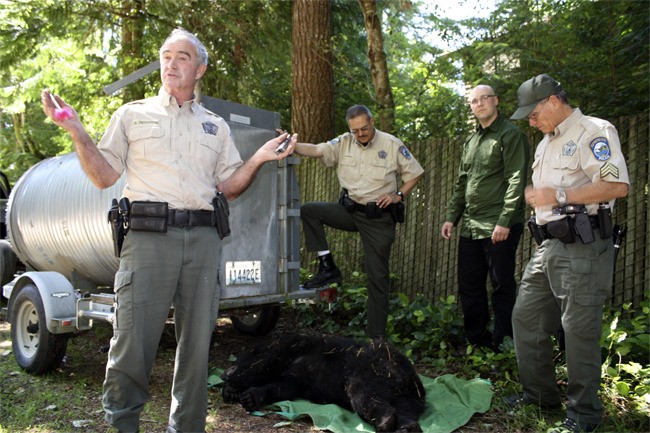A low, steady moan comes from inside the steel tube as Sgt. Kim Chandler approaches.
When he gets too close, the occupant lets out a huffy snort, and Chandler springs back, not eager to get his face coated in bear sneeze.
Chandler and four other Washington Department of Fish and Wildlife officers had trapped the bear in the usual way—Krispy Kreme donuts are the favored bait—but were in for a surprise after they shot the animal with a tranquilizer dart in the shoulder.
The snoozing bear, weighing more than 200 pounds, was a mature mother bear, and all signs suggested that she had at least one cub somewhere in the vicinity.
“This is an unexpected problem,” Chandler said. “We can’t take this bear away from the cub.”
The game plan changed. Instead of hauling her from Lake Alice to a remote wooded area many miles away, the officers decided to wait and see whether they could trap a cub, too. If not, they’d have to release her in the local area.
Garbage bears
The mama bear was the second of two of the big omnivores trapped in the vicinity of Snoqualmie in a week. Last Friday, wildlife officers captured a 147-pound bear in a trap in the Cascade Avenue neighborhood of Snoqualmie Ridge. That animal was turned over to Progressive Animal Welfare Society, or PAWS, for treatment for apparent wounds to its eyes, and was later euthanized
Than, last Saturday, a trap was set at a Lake Alice home after a resident complained about an agressive bear seeking food on his property.
The homeowner had been doing everything right, Chandler said—keeping trash inside his garage until pickup.But, working in his garage one day, the man was surprised by a bear walking inside with him.
Lake Alice has always been bear territory, but the proximity of people has changed things for the bears.
“These garbage bears drive us nuts,” Chandler said.
Nine times out of ten, bears are merely a nuisance. Depredation and human attacks are rare. For this Lake Alice bear, however, a line was crossed when she entered that garage.
These animals are supposed to be eating berries at this time of year.
“But the fat you get off human food, there’s a lot more calories than a berry,” said wildlife officer Bruce Richards. With the animals focused on packing on fat reserves for the winter, “It’s all about food for these bears,” he added.
The animal surprised officers with its weight, maxing out the scale at 225 pounds. Her long, darkened teeth confirmed her age, about five or six years.
“The bad thing is, up until this point, mom has been teaching junior bad stuff,” he said. “We’ve interrupted it. But now we’ve got a youngster who understands that garbage cans are an easy meal. It’s a tough situation.”
The officers planned to perform a “hard release,” scaring the just-freed bear with shouts, barking dogs, firecrackers and beanbag shotgun blasts.
That rude treatment generally instills a strong fear of humans—and their traps—but the possibility remains that the bear may be too set in its ways. That means a deportation out of the area, should this bear become a nuisance again.
Newly tagged, “She’ll get one chance,” Chandler said. “If she doesn’t learn, and she keeps getting into stuff, it’s going to be really hard to catch her again. They’re smart… It’s going to be a tough road.”
The Department of Fish and Wildlife’s main concern is for animals, and officers try to treat them with respect and care.
“We have to balance that with homeowner concerns. It’s unnerving when you’ve got kids, and bears are looking in the window.”
After weighing, Richards, Chandler and company watched the bear for a moment to make sure she was still breathing, then lifted her back into the trap, spreading out her legs to make sure she was in a comfortable sleeping position.
Wednesday’s trapping also gave the officers a chance to let their specially trained Karelian Bear Dogs get up close and personal with their main prey.
“These dogs are a valuable tool for us,” Chandler said.
Officers set a new trap for a cub, and waited two days before performing a hard release. That approach seems to have worked. The bear, with two cubs in tow and sporting a GPS collar, was last detected south of Interstate 90, headed south.



